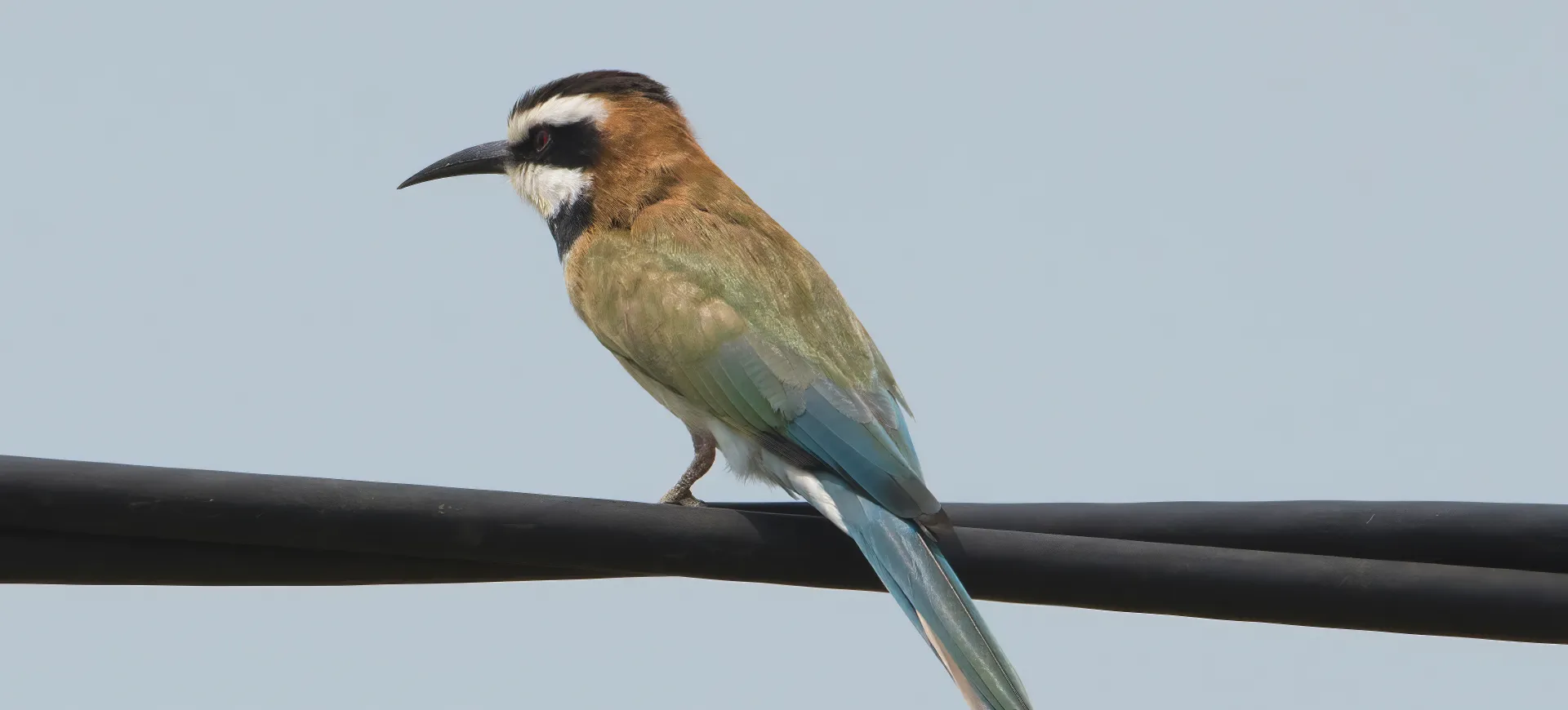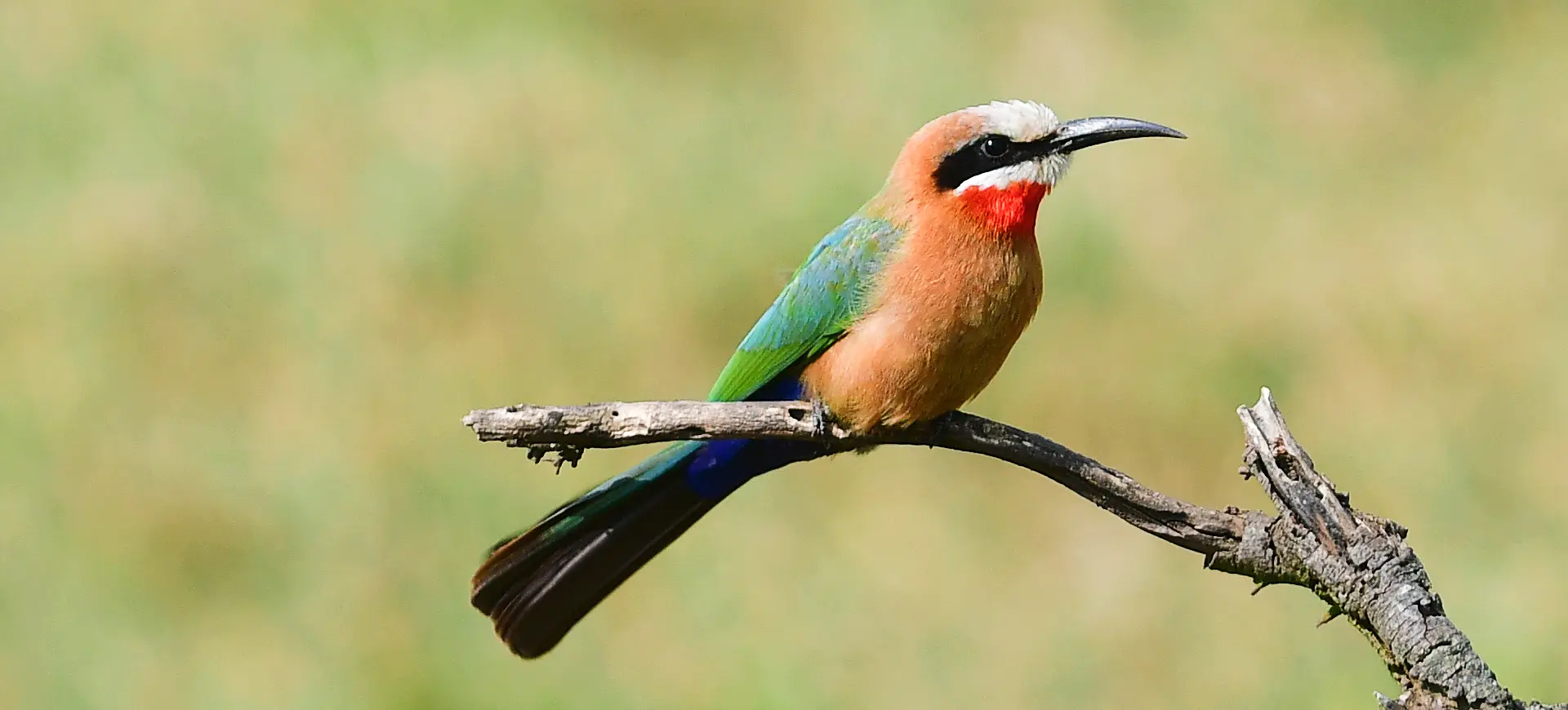Overview
The Northern Carmine Bee-eater (Merops nubicus) is a vibrant and striking bird renowned for its rich carmine-red plumage and graceful flight. This species is among the largest of the bee-eaters, a group known for their vivid colors and aerial insect-hunting skills. Inhabiting the skies of sub-Saharan Africa and parts of the Arabian Peninsula, these birds are easily recognizable by their long, pointed wings and deeply forked tails, which enable their acrobatic flying abilities. The Northern Carmine Bee-eater’s diet primarily consists of bees and wasps, which they catch in mid-air with remarkable precision, playing a crucial role in controlling insect populations.
During the breeding season, Northern Carmine Bee-eaters gather in large colonies, excavating nest tunnels in sandy riverbanks. This communal nesting behavior reflects their social nature and provides added protection against predators. The male’s plumage becomes especially vibrant during this period, serving as a visual cue to attract mates and assert dominance within colonies. These birds are also known for their cooperative breeding system, where non-breeding individuals assist in feeding and defending the nestlings, showcasing a complex social structure that enhances the survival of their young.
Despite facing threats from habitat destruction and climate change, the Northern Carmine Bee-eater remains classified as Least Concern by the IUCN, thanks to its wide distribution and stable population sizes. However, the loss of suitable nesting sites and feeding grounds due to agricultural expansion and riverbank modification poses challenges to local populations. Conservation efforts focusing on protecting natural habitats and sustainable land use practices are essential to ensure the continued thriving of these spectacular birds. The Northern Carmine Bee-eater’s role in insect control and its ecological significance underscore the importance of maintaining healthy ecosystems for avian species and human communities.
Taxonomy
Kingdom
Phylum
Class
Order
Family
Genus
Species
Type
Physical Description:
The Northern Carmine Bee-eater is a visually stunning bird, characterized by its deep carmine-red plumage covering most of its body, with blue on the lower back and rump and a distinctive black mask across its eyes. The bird’s long, slender bill is perfectly adapted for catching insects in flight, a testament to its specialized feeding habits. Adults can reach lengths up to 12 inches (30 cm), including the elongated central tail feathers characteristic of breeding males. The bright plumage serves as a mating display, making them one of the most easily identifiable and photographed birds in their range.
Despite the color uniformity, juveniles exhibit a slightly duller tone than adults, gaining their full, vibrant colors as they mature. The sexual dimorphism in this species is minimal, with males and females sporting similarly striking colors, though males may display slightly brighter hues during the breeding season. Their wings are long and pointed, designed for efficient and agile flight, enabling them to perform acrobatic maneuvers while hunting airborne insects. The Northern Carmine Bee-eater’s physical attributes, including its vivid colors and flight capabilities, reflect its adaptation to a life predominantly in the air.

Lifespan: Wild: ~12 years || Captivity: ~15 years

Weight: Male: 1.9-2.1 oz (55-60 g) || Female: 1.9-2.1 oz (55-60 g)

Length: Male: 9-12 in (23-30 cm) || Female: 9-12 in (23-30 cm)

Wingspan: Male & Female: 18-20 in (46-51 cm)

Top Speed: 20 mph (32 km/h)
Characteristic:
Native Habitat:
The Northern Carmine Bee-eater inhabits a wide range of open landscapes across sub-Saharan Africa, from arid savannas to lush river valleys. They prefer areas with abundant insect populations and suitable nesting sites, such as sandy riverbanks or flat ground, where they can excavate their burrow nests. These habitats provide essential resources for feeding and breeding and offer opportunities for large communal nesting colonies, a characteristic behavior of the species. The proximity to water bodies is particularly crucial, as it supports a rich diversity of insect prey and suitable nesting conditions.
Migration is a significant aspect of their life cycle, with populations moving seasonally between breeding and non-breeding areas to take advantage of changing food resources. This nomadic behavior allows them to exploit different ecosystems throughout the year, from the arid Sahel region during the rainy season to more southerly locations in the dry season. The adaptability of the Northern Carmine Bee-eater to various habitats underscores their resilience and the importance of conserving diverse African landscapes to support migratory bird species.
Climate Zones:
Biomes:
Biogeographical Realms:
Continents:
Countries:
Diet:
Diet & Feeding Habits:
Northern Carmine Bee-eaters primarily feed on a wide variety of flying insects, with a particular preference for bees and wasps, which they skillfully catch in mid-air. Their hunting technique involves perching on a high vantage point, such as a tree branch or wire, from where they launch into flight to catch their prey. After capturing an insect, bee-eaters return to their perch to beat the prey against a hard surface, removing the sting and venom before consumption. This behavior showcases their specialized feeding habits and their role in controlling insect populations, benefiting agricultural areas by reducing the number of pest insects.
In addition to their primary diet, these bee-eaters occasionally consume butterflies, dragonflies, and other small flying insects, demonstrating flexibility in their feeding behavior. The communal nature of their hunting grounds, often shared with other species members, emphasizes their social behavior and the importance of suitable feeding territories. The diet of the Northern Carmine Bee-eater plays a crucial role in their reproductive success, influencing their choice of breeding sites close to abundant food sources. Their feeding habits underline the intricate balance between avian predators and insect prey within ecosystems, highlighting the interconnectedness of species and their environments.
Mating Behavior:
Mating Description:
The Northern Carmine Bee-eater’s breeding season is characterized by the formation of large, noisy colonies along riverbanks or in open ground, where they excavate nest tunnels. Males play a prominent role in courtship displays, showcasing their vibrant plumage and aerial agility to attract females. These displays include a series of flights, dives, and calls performed solo and in groups to demonstrate their fitness and secure a mate. Following successful courtship, pairs work together to dig nesting burrows using their bills and feet to strengthen pair bonds and ensure a safe environment for their offspring.
Once the nest is established, females lay up to 5 eggs, which are incubated by both parents, reflecting their shared investment in the success of their brood. The communal nature of their nesting sites provides added protection against predators, with multiple pairs often assisting in defense and alerting the colony to potential threats. This cooperative breeding strategy, coupled with their elaborate courtship rituals, underscores the complex social behavior of the Northern Carmine Bee-eater, contributing to their reproductive success and the survival of their young.
Reproduction Season:
Birth Type:
Pregnancy Duration:
Female Name:
Male Name:
Baby Name:
Social Structure Description:
The Northern Carmine Bee-eater exhibits a highly social behavior, particularly evident in their communal nesting colonies, where hundreds or thousands of individuals come together. These colonies facilitate breeding and provide a mechanism for collective defense against predators, with multiple birds often mobbing potential threats to protect their nests. Outside the breeding season, bee-eaters form large flocks that migrate and forage together, showcasing their gregarious nature and the benefits of social living, such as increased foraging efficiency and protection.
The cooperative breeding system, where non-breeding individuals assist in feeding and defending the nestlings, highlights the complex social dynamics within colonies. This behavior not only enhances the survival rate of chicks but also strengthens social bonds among colony members, playing a crucial role in the species’ overall success. Understanding the social structure of the Northern Carmine Bee-eater provides insights into their behavior, ecology, and the evolutionary pressures that have shaped their communal living strategies.
Groups:
Conservation Status:
Population Trend:
Currently classified as Least Concern by the IUCN, the Northern Carmine Bee-eater benefits from wide distribution and relatively stable populations in sub-Saharan Africa. Their adaptability to various habitats and migratory behavior has enabled them to thrive in diverse environments, from arid savannas to fertile river valleys. While the species does not face immediate threats on a global scale, local populations may be impacted by habitat destruction, pollution, and climate change, highlighting the need for continued conservation efforts.
Protecting the natural habitats of the Northern Carmine Bee-eater, particularly breeding and feeding sites, is essential for ensuring the species’ long-term survival. Efforts to preserve riverbanks from erosion and development, along with the sustainable management of agricultural lands, can help maintain the ecological balance necessary for these birds and other wildlife. Conservation programs that focus on habitat protection, along with research and monitoring, will be crucial for understanding the impacts of environmental changes on bee-eater populations and developing effective strategies for their preservation.
Population Threats:
The primary threats to the Northern Carmine Bee-eater include habitat destruction due to agricultural expansion, deforestation, and the development of riverbank areas. These activities can lead to the loss of essential nesting and feeding habitats, directly impacting their breeding success and survival. Additionally, pesticide use in agriculture poses a significant risk, potentially reducing insect populations that constitute the bee-eater’s main food source and exposing the birds to harmful chemicals. Climate change also presents a long-term threat, with alterations in precipitation patterns and river flows affecting the availability of suitable nesting sites and food resources.
Despite these challenges, the Northern Carmine Bee-eater’s wide range and generalist feeding habits provide some buffer against localized habitat changes. Conservation strategies that address habitat loss and environmental pollution, along with efforts to mitigate the impacts of climate change, are vital for protecting this species and the broader biodiversity of their ecosystems.
Conservation Efforts:
The Northern Carmine Bee-eater’s conservation efforts focus on habitat preservation and the sustainable management of natural resources. Protecting riverbanks from erosion and development is critical for maintaining the availability of suitable nesting sites, while the conservation of open landscapes supports abundant insect populations necessary for feeding. Initiatives that promote eco-friendly agriculture and reduce pesticide use can also benefit the bee-eater and other insectivorous birds, contributing to healthier ecosystems.
Engaging local communities in conservation activities, such as habitat restoration and creating protected areas, can foster a shared sense of responsibility for wildlife preservation. Education and awareness programs that highlight the ecological importance of the Northern Carmine Bee-eater and the threats they face can encourage support for conservation measures. By combining habitat protection with community engagement and environmental education, conservationists can ensure the continued thriving of the Northern Carmine Bee-eater and the rich biodiversity of their habitats.
Additional Resources:
Fun Facts
- The Northern Carmine Bee-eater can catch and consume up to 500 bees and wasps in a single day, showcasing their incredible hunting skills.
- They have a unique method of dealing with the stings of their prey: rubbing the insect against a hard surface to extract the sting before eating.
- These bee-eaters are known for their spectacular communal nesting colonies, which can number thousands and create a breathtaking visual spectacle.
- The species is crucial in controlling insect populations, benefiting agricultural areas by reducing pest numbers.
- Their vibrant carmine-red plumage makes them one of Africa’s most sought-after subjects for birdwatchers and wildlife photographers.
- Northern Carmine Bee-eaters are expert flyers, capable of performing intricate aerial maneuvers to catch their insect prey.
- They are one of the few bird species known to engage in cooperative breeding, where individuals help raise the offspring of others.
- The migration patterns of the Northern Carmine Bee-eater are closely linked to seasonal changes, demonstrating their adaptability to different environments.
- Despite their name, bee-eaters consume various flying insects, including butterflies and dragonflies.
- Conservation efforts focused on habitat preservation and sustainable land use practices are essential for ensuring the continued survival of these magnificent birds.










